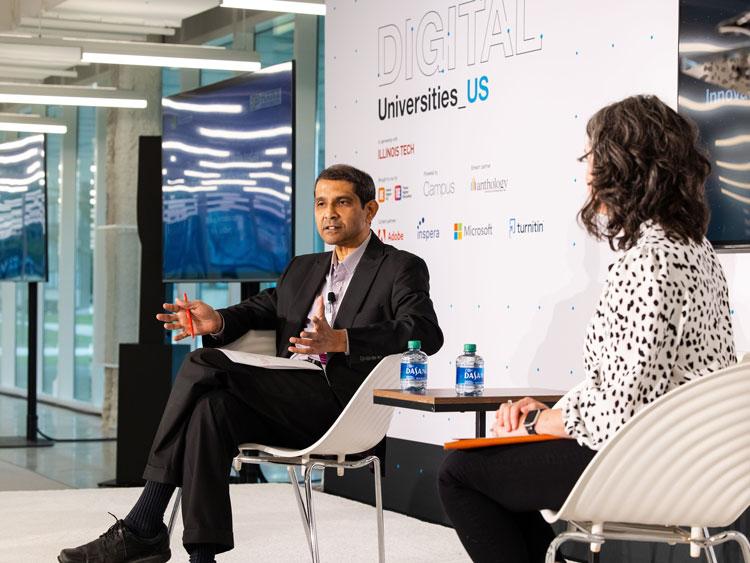
Career-connected learning is an investment in the future
A strong reputation for career-connected learning can create a seamless circle for universities, with graduates happy to pave the way for others via the alumni network. But how to get started?
Career-connected learning integrates career exploration and job-ready knowledge, skills and abilities into the curriculum, programme by programme. For students, it carves out a path towards professional preparation, gives them the space to develop a specialised focus while maintaining progress towards a credential and the skills that employers seek for leadership positions in their organisations. Finally, to prepare students for the workforce, career-connected learning offers high-impact experiences: internships, co-ops, apprenticeships and mentorships that take place beyond campus.
Stakeholders are driving alignment between workforce needs and higher education’s academic work. Also, with the cost of access to the first rungs of tertiary education, students and their families need assurance that pursuing higher education is the right path forward. Graduates from institutions that have based academic planning on career-connected learning will see a demonstrable return on their investment. But there are benefits for the university, too, in connecting learning to careers.
- Career mentoring can support student employability
- Strategies to train students in three transferable skills wanted by employers
- Empowering international students for global career success
Successful career outcomes for graduates boost a university’s reputation, improve its rankings and attract attention to its academic offerings, therefore reducing cost per acquisition in the enrolment pipeline.
Universities can offer learners more high-impact experiences, support and resources when marketing and enrolment costs are driven down at the beginning of the student journey. Students who experience internships, co-ops and mentorships as part of a career-connected programme find relevance in the curriculum, including the skills they need for the workplace and the challenges they may encounter there.
Building social mobility
When we offer a strong return on investment for our graduates, we can bolster our claim of being a public good and holding up our end of the social contract. Our graduates become high earners and taxpayers, in turn investing in their communities and taking an active part in building a high standard of living.
Universities are key for the societal needs of those who create economic growth. Successful university graduates become engaged alumni, willing to form strong industry partnerships with their alma mater, as well as other career-connected tertiary institutions. Alumni networks can pave the way to jobs, creating a virtuous circle in which new graduates experience the return on investment the university’s reputation was built on. The career-connected cycle maintains its momentum.
Develop a framework
In my role as a chief academic officer, I have prioritised career-connected learning in the programme review process. The first step will be developing an academic planning framework with career readiness as the focus. The framework includes surveying alumni about the return on their investment that they’ve experienced in real terms – job promotion, getting a position in their desired field, raises and increases in income – that they attribute to their university education.
Strong returns for graduates show the strengths in academic courses and help faculty to hone in on the delivery of more career-connected programmes to the public. Career-connected programmes can be measured and assessed according to:
Contribution to mission achievement: The university can assess declines and increases in enrolment programme-by-programme to find where students are finding value.
Quality: Programme review measures should determine:
- how often courses are reviewed, modified and updated in a formal process
- how external input has been sought to improve the offerings
- how students are retaining in the programmes
- how graduates are faring in the job market with a return on their investment in education
Viability: Course-level reviews help programme planning by measuring:
- registered students who commit to their programme of study
- degrees awarded over time — and time to student completion
- comparisons of courses with regional and local competitors
Sustainability: Financial reviews of programmes and courses offer insights into:
- programme enrolment and revenue
- direct costs, fixed and variable
- indirect costs
As more higher education leaders adopt a return on investment-based model for assessing universities’ outcomes, one fact becomes increasingly clear: graduates from career-connected institutions experience an increase in quality of life, lifetime earnings and better potential to grasp opportunities.
Public rhetoric may seem to be against higher education right now on ideological grounds, but the very real return on their investment that graduates gain is undeniable. With a career-connected framework supporting chief academic officers’ academic planning and public relations, universities have a chance to take back the conversation and point to the mutual benefits that post-secondary learning gives to our students, our communities and our future.
Audra Spicer is provost and chief academic officer at Colorado State University Global.
If you would like advice and insight from academics and university staff delivered direct to your inbox each week, sign up for the Campus newsletter.




